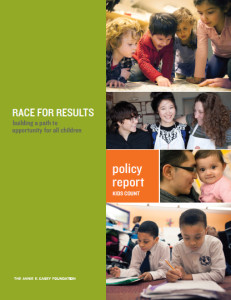New report examines opportunity across racial categories, with recommendations for schools
 Every parent wants the best for their children – a safe neighborhood with a healthy environment, a supportive community proud of its students, teachers and schools, and paths to jobs that offer security and social mobility. In a country with phenomenal cultural diversity, the hopes of parents are a constant that varies little across cultures, ethnicities and experiences of migration.
Every parent wants the best for their children – a safe neighborhood with a healthy environment, a supportive community proud of its students, teachers and schools, and paths to jobs that offer security and social mobility. In a country with phenomenal cultural diversity, the hopes of parents are a constant that varies little across cultures, ethnicities and experiences of migration.
But as researchers at the Annie E. Casey Foundation have been documenting for the past 25 years, the opportunities available to different children in the United States vary greatly. A child’s well-being and future prospects have a great deal to do with the race of that child’s parents, and the odds are stacked against children of color.
The Foundation’s recently-released report, “Race for Results: Building a Path to Opportunity for All Children,” finds that, despite significant progress reaped by social movements and anti-poverty policymakers, “Children of color are more likely to fall out of the middle class and are more likely to stay in the lower class as adults.”
The report features the new Race for Results Index, which compares how children are progressing on key milestones across racial and ethnic groups at the national and state level. The index is based on 12 indicators that measure a child’s success in each stage of life, from birth to adulthood, in the areas of early childhood; education and early work; family supports; and neighborhood context.
Here are just a few of the findings in brief:
- No one racial group has all children meeting all milestones; African-American, American Indian and Latino children, in particular, face some of the biggest obstacles on the pathway to opportunity (8).
- Fourth grade reading and eighth grade math proficiency rates — indicators of long-term success in school and in the workforce — are low across all groups (8).
- American Indian and Latino children are least likely to attend early childhood education programs (8).
- Just 63% of Latino children live in a household where someone has at least a high school diploma, compared to a national average of 85% of children (9).
- African American, Latino and American Indian children are far less likely to live in neighborhoods where poverty is low and thus far more likely to grow up in communities where schools are poorer and access to capital, fresh produce, transit and health care is more limited (11);
- Among Asian and Pacific Islanders, children in Hmong, Laotian, Cambodian and Vietnamese families are far less likely to live in neighborhoods where poverty is low than are Asian Indian or Filipino children.
The authors of “Race for Results” underscore a methodological truism. To improve the life chances of all children, including children of color, we need to first be able to see the disparities clearly. Measurement makes inequity visible, and disaggregating data by race makes the experience of children of color visible.
“Decisions on where and how to create opportunity cannot be viewed through a colorblind lens, but rather through a clear picture of yesterday’s history, today’s reality and tomorrow’s hope for the nation’s future.” (5)
The Recommendations section of “Race for Results” offers many promising directions for creating pathways to opportunity for children of color and managing and allocating resources that help children and their families to thrive. In brief:
- It is important for every public system to collect and analyze racial and ethnic data if we are to understand the factors, patterns and trends that contribute to disparities.
- Data and impact assessment tools can help school districts, counties, juvenile justice agencies and corporations to target investments to yield the greatest impact for children of color.
- To improve outcomes for children of color, programs and practices must focus on children of color and they must be substantiated by evidence. Emerging practices that show promise should be allowed to continue.
- Economic inclusion strategies that explicitly connect vulnerable groups to new, high quality jobs should be integrated within economic and workforce development efforts.
“Race for Results” incorporates knowledge and tools created by a number of organizations that are well respected for their work to advance racial equity, including the Kirwan Institute for the Study of Race and Ethnicity, The Opportunity Agenda, PolicyLink, W. Hayward Burns Institute and Race Forward.
—————————————————-
Read the full study, “Race for Results: Building a Path to Opportunity for All Children” on the Annie E. Casey Foundation website.




